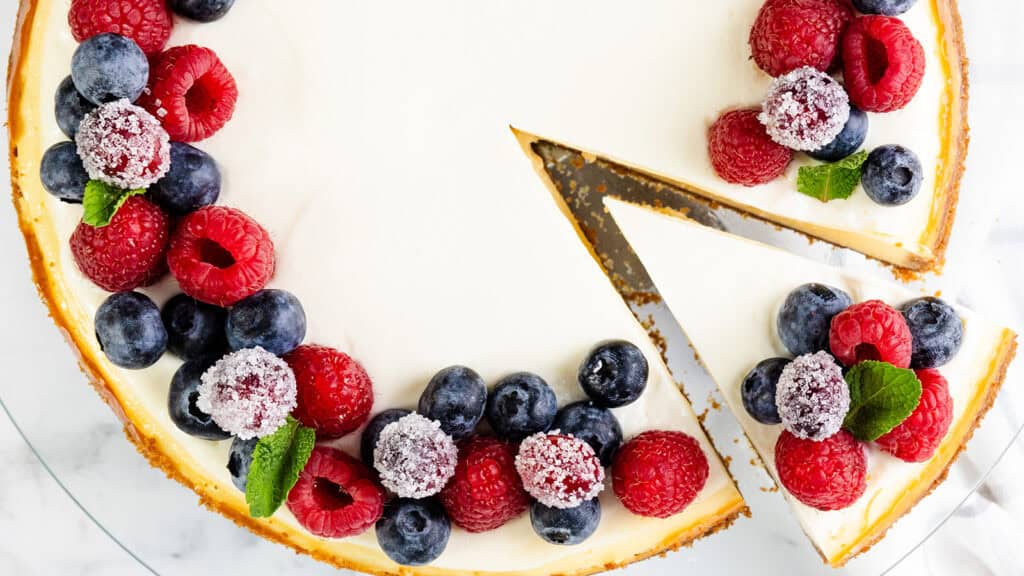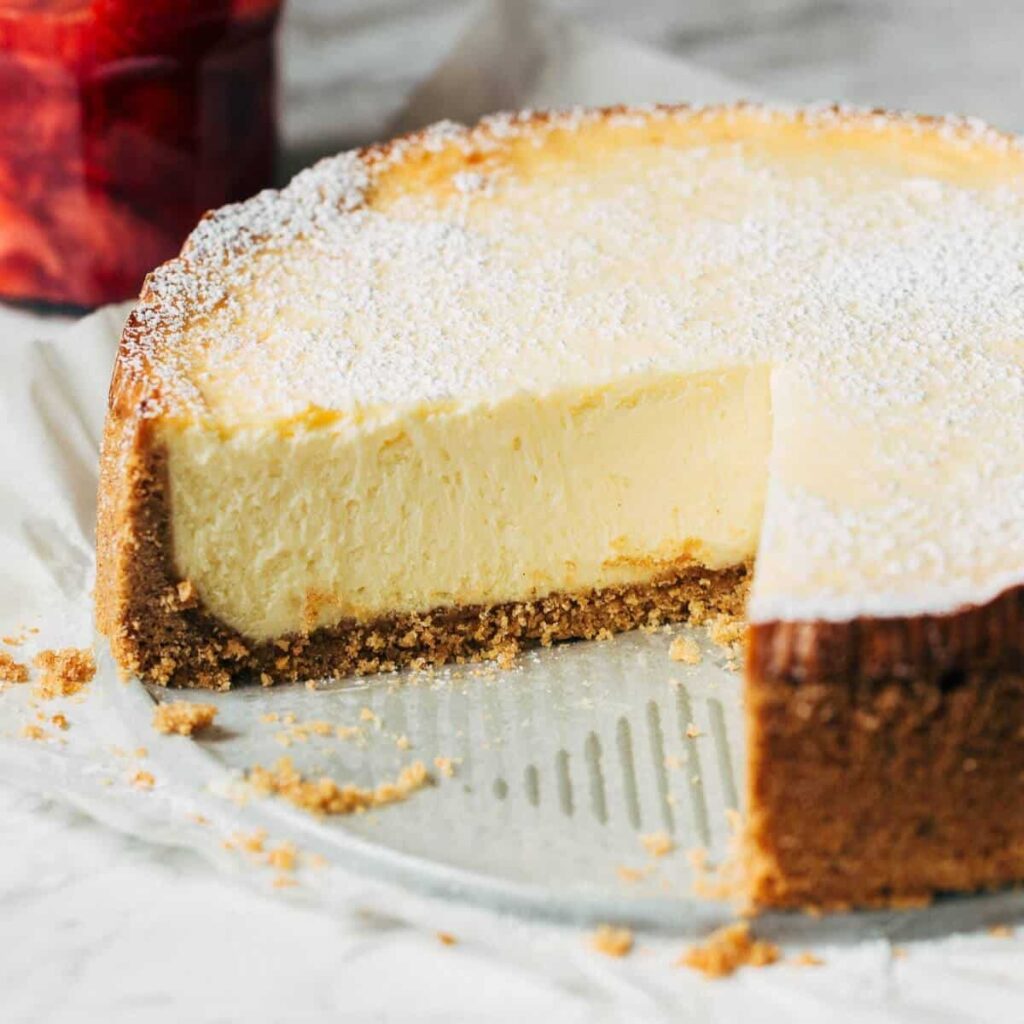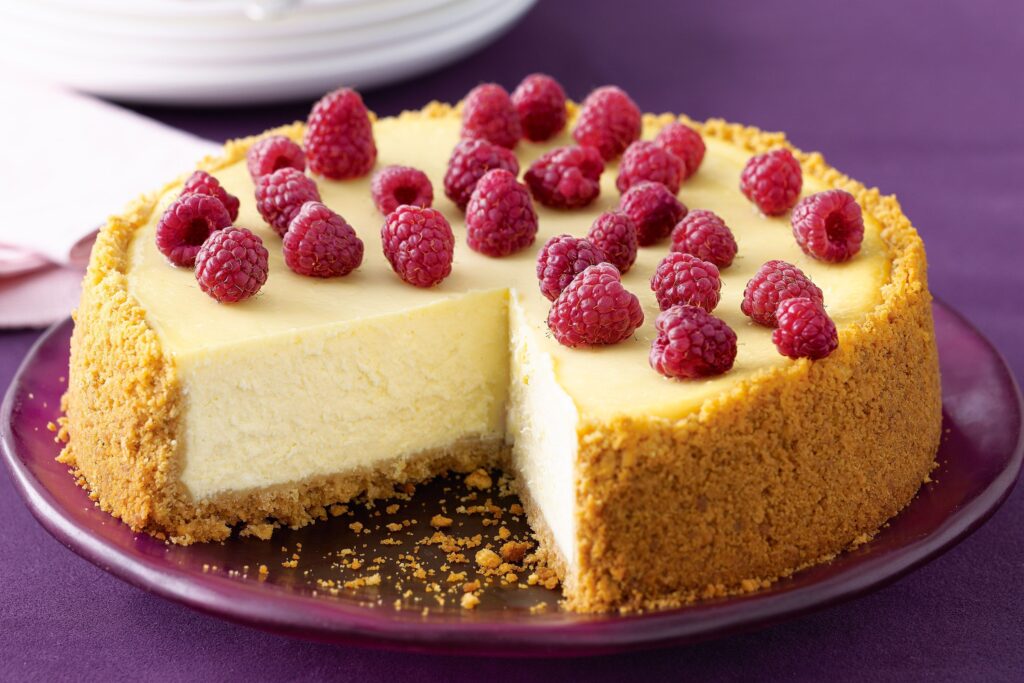Welcome to our ultimate guide on baking the perfect classic New York style cheesecake! If you’re yearning for that dense, creamy, velvety texture with a subtle tang and a buttery graham cracker crust, this is your go-to resource. New York style cheesecake stands out for its richness, achieved through generous amounts of cream cheese, eggs, and a touch of sour cream or heavy cream, baked low and slow to perfection. It’s a showstopper dessert for holidays, dinner parties, or simply indulging at home, and with the right techniques, you can replicate bakery-quality results without the fuss.
In this SEO-optimized article, we’ll unveil 7 key secrets to mastering this iconic treat. From its captivating history to essential ingredients, a step-by-step recipe, delicious variations, baking tips, storage and serving suggestions, nutritional details, and frequently asked questions, we’ve got everything covered. We’ll incorporate internal links to related recipes on our site, such as our classic chocolate chip cookies, peanut butter cookies, no-bake chocolate oatmeal cookies, or bakery-style blueberry muffins, and external links to credible sources for deeper insights. New York Style Cheesecake Whether you’re a novice baker tackling your first cheesecake or a seasoned pro refining your method, this guide ensures a crack-free, creamy masterpiece every time.

New York style cheesecake is more than a dessert—it’s a cultural icon, blending European roots with American innovation. With prep time around 20 minutes and baking in about an hour (plus chilling), you’ll have a luxurious treat ready to impress. Let’s uncover the secrets and get your springform pan ready!
Secret 1: The Fascinating History of New York Style Cheesecake
The story of New York style cheesecake is a delicious journey through time, blending ancient traditions with modern American flair. Cheesecake’s origins date back over 4,000 years to ancient Greece, where it was served to athletes during the first Olympic Games in 776 BC as an energy booster. Made from cheese, honey, and wheat, it was a simple pounded cake. The Romans adopted and spread the recipe across Europe after conquering Greece, evolving it into something closer to today’s versions with eggs and a baked crust.
Fast-forward to the 19th century: European immigrants brought cheesecake recipes to America. Early versions used cottage cheese or ricotta, but the game-changer came in 1872 when William Lawrence, a New York dairyman, accidentally invented cream cheese while trying to replicate French Neufchâtel. New York Style Cheesecake This smooth, creamy product, marketed as Philadelphia Cream Cheese after 1880, revolutionized the dessert.

The distinct “New York style” emerged in the 1920s-1930s, credited to Arnold Reuben, the restaurateur famous for the Reuben sandwich. After tasting a cheese pie at a dinner party, Reuben experimented at his Manhattan spots, Reuben’s Restaurant and The Turf, creating a denser, creamier version using cream cheese, heavy cream, eggs, and a graham cracker crust. This style gained fame in Jewish delis and bakeries, where it was often called “Jewish cheesecake.”
By the mid-20th century, New York cheesecake became synonymous with the city’s culinary scene, featured in iconic spots like Junior’s in Brooklyn (famous since 1950) and Lindy’s. New York Style Cheesecake Its popularity exploded nationally through cookbooks and media, solidifying its status as a dense, tall, and unadorned classic—often topped simply with sour cream or fruit.
This evolution highlights how immigration, invention, and urban innovation shaped a global favorite. For more dessert histories, explore our history of American baking. Externally, Cheesecake.com provides an in-depth timeline.
Secret 2: Essential Ingredients for Classic New York Style Cheesecake
The hallmark of a classic New York style cheesecake is its luxurious texture, derived from high-quality, simple ingredients. Unlike lighter versions, this style emphasizes density with ample cream cheese and eggs. Let’s break down the essentials, their roles, and tips for selection, New York Style Cheesecake drawing from trusted recipes.
Crust:
- Graham Crackers: 1 1/2-2 cups crumbs form the base. Honey-flavored add sweetness; crush finely for even texture.
- Butter: 1/2 cup melted binds the crumbs. Unsalted controls saltiness.
- Sugar: 1/4 cup granulated enhances flavor. Some add cinnamon for warmth.
Filling:
- Cream Cheese: 4-5 (8-oz) packages (32-40 oz total), full-fat Philadelphia for authenticity. Room temperature prevents lumps; it’s the star for creaminess.
- Sugar: 1 1/4-1 1/2 cups granulated. Balances tang; too little makes it bland.
- Eggs: 4-5 large, plus 1-2 yolks for richness. Add one at a time to incorporate air gently.
- Sour Cream or Heavy Cream: 1 cup adds tang and silkiness. Sour cream for classic New York density; heavy cream for lighter feel.
- Vanilla Extract: 1-2 tsp pure for depth. Lemon zest (1 tsp) optional for brightness.
- Flour or Cornstarch: 2-3 tbsp. all-purpose or cornstarch thickens without toughness.
Topping (Optional):
- Sour cream mixed with sugar and vanilla for a glossy layer.
A standard recipe yields an 8-10 inch cheesecake: 1 1/2 cups graham crumbs, 1/4 cup sugar, 1/2 cup butter for crust; 32 oz cream cheese, 1 1/4 cups sugar, 4 eggs, 1 cup sour cream, 2 tbsp flour, 1 tsp vanilla for filling.
Quality is key—use full-fat dairy for richness; avoid low-fat substitutes that lead to watery results. For sourcing, check King Arthur Baking for flours and extracts. Room-temperature ingredients ensure smooth blending, preventing cracks.
Understanding these components lets you customize—more eggs for density, less sugar for tartness. For gluten-free, swap graham crackers with almond flour crust.
Secret 3: Step-by-Step Recipe for Classic New York Style Cheesecake
Ready to bake? This classic New York style cheesecake recipe yields a tall, creamy 9-inch cake serving 12-16. It uses a water bath for even cooking and crack prevention, inspired by foolproof methods.
Prep Time: 20 minutes | Bake Time: 60-75 minutes | Chill Time: 8 hours+ | Total Time: 9 hours | Yield: 12-16 slices

Ingredients:
- Crust: 1 1/2 cups graham cracker crumbs, 1/4 cup sugar, 1/2 cup melted butter
- Filling: 32 oz. (4 packages) cream cheese, softened; 1 1/4 cups sugar; 4 large eggs; 1 cup sour cream; 2 tbsp. all-purpose flour; 2 tsp vanilla extract; Optional: 1 tsp lemon zest
- Topping: 1 cup sour cream, 2 tbsp. sugar, 1/2 tsp vanilla (optional)
Instructions:
- Preheat and Prep Pan: Heat oven to 325°F (163°C). Grease a 9-inch springform pan. Wrap exterior in two layers of foil for water bath.
- Make Crust: Mix crumbs, sugar, and butter. Press into pan bottom and 1 inch up sides. Bake 10 minutes; cool.
- Cream Cheese Base: Beat cream cheese until smooth (2-3 minutes). Add sugar gradually; beat until fluffy.
- Add Eggs: Incorporate one at a time on low speed, scraping sides.
- Mix in Rest: Add sour cream, flour, vanilla, and zest. Mix until just combined—avoid overbeating.
- Pour and Bake: Pour over crust. Place in roasting pan; add hot water halfway up sides. Bake 60-75 minutes until edges set but center jiggles slightly.
- Cool Gradually: Turn off oven; leave door ajar 1 hour. Remove, run knife around edges. Cool to room temp, then chill 8+ hours.
- Optional Topping: Mix sour cream, sugar, vanilla; spread on cooled cake. Bake 5 minutes at 350°F for set.
For video guidance, see this tutorial. Key: Low temp prevents cracks; New York Style Cheesecake water bath ensures creaminess.
This recipe is adaptable—pair with our beef stew for a savory contrast.
Secret 4: Delicious Variations to Try
Once you’ve nailed the classic, explore these variations to keep your New York style cheesecake exciting, while honoring its dense base.
- Strawberry Topped: Add fresh strawberry sauce or compote post-bake for fruity contrast.
- Chocolate Swirl: Melt chocolate into part of batter; swirl for marbled effect.
- Lemon Blueberry: Infuse lemon zest/juice; fold in blueberries. Like our blueberry muffins.
- Oreo Crust: Swap graham for Oreo crumbs; add cookies to filling for cookies-and-cream.
- Pumpkin Spice: Mix pumpkin puree and spices into filling for fall twist.
- Vegan: Use cashew/almond cream cheese substitutes, coconut cream, and flax eggs.
- Mini Cheesecakes: Bake in muffin tins for individual servings—reduce time to 20-25 minutes.
For more ideas, see Oh My Veggies’ creative list. These maintain the New York New York Style Cheesecake density while adding flair.
Secret 5: Pro Tips for Perfect Cheesecake Every Time
Achieve flawless results with these expert tips:
- Room-Temp Ingredients: Prevents lumps; ensures smooth batter.
- Water Bath Essential: Moist heat for even baking, no cracks. Foil-wrap pan tightly.
- Don’t Overmix: After eggs, mix low to avoid air bubbles causing cracks.
- Gradual Cooling: Oven door ajar prevents sinking.
- Jiggle Test: Center should wobble like Jell-O when done.
- Chill Thoroughly: Overnight for best texture.
- Knife Run: Around edges post-bake to prevent sticking/cracking.
Avoid common pitfalls like high heat (causes browning/cracks) or overbaking (dry texture).
Secret 6: Storage and Serving Suggestions
Store wrapped in fridge up to 5 days; freeze slices up to 3 months—thaw overnight.
Serve chilled or room temp with fresh berries, caramel, or whipped cream. Pair with coffee or wine for elegance. Gift in tins for holidays.
Secret 7: Nutritional Information and Healthier Options
Per slice (12 servings): ~400-500 calories, 30-35g fat (20g saturated), 35-40g carbs (25g sugar), 7-8g protein. High in calcium from cheese.
Healthier: Use reduced-fat cream cheese, less sugar, or Greek yogurt swap. Add fruits for fiber. New York Style Cheesecake Indulge moderately!
Frequently Asked Questions
Why Your Cheesecake Cracks
- Overbaking: Baking a cheesecake too long causes the proteins in the eggs and cream cheese to over-coagulate, tightening the structure and causing cracks as it contracts during cooling. The Classic New York Style Cheesecake guide emphasizes the importance of a jiggly center to avoid this.
- Fix: Bake until the edges are set but the center (about 2-3 inches in diameter) still jiggles like Jell-O when gently shaken, typically 60-75 minutes at 325°F for a 9-inch cheesecake. Use an instant-read thermometer; the internal temperature should be around 150°F for a creamy texture. Remove from the oven promptly to avoid residual heat overcooking.
- Sudden Temperature Changes: Rapid cooling after baking causes the cheesecake to contract too quickly, leading to surface cracks. This is especially true if you move it from a hot oven to a cool counter without a gradual transition.
- Fix: Cool the cheesecake gradually. After baking, turn off the oven, crack the door open, and let the cheesecake sit inside for 1 hour. Then, transfer to the counter to cool to room temperature before refrigerating for at least 8 hours. This slow cooling minimizes stress on the structure.
- Overmixing the Batter: Incorporating too much air into the batter by overmixing, especially after adding eggs, can cause the cheesecake to puff up during baking and crack as it deflates. This is a common mistake with dense recipes like New York style cheesecake.
- Fix: Mix on low speed after adding eggs, just until incorporated, and scrape the bowl to ensure even blending without overbeating. Use room-temperature ingredients to reduce mixing time and prevent lumps, which might tempt you to overmix.
- Skipping the Water Bath: Baking without a water bath leads to uneven heat distribution, causing the cheesecake to rise too quickly or dry out, both of which promote cracking. The water bath is a hallmark of the Classic New York Style Cheesecake recipe for its moist, even heat.
- Fix: Use a water bath. Wrap the springform pan tightly in two layers of heavy-duty foil to prevent leaks, place it in a roasting pan, and fill with hot water halfway up the pan’s sides. Bake at 325°F to maintain a gentle, moist environment.Fix: Bake at the recommended 325°F and place the cheesecake on the middle rack. Use an oven thermometer to verify temperature accuracy, as some ovens run hot. If cracks persist, lower the temperature to 300°F and extend baking time slightly, New York Style Cheesecake always using a water bath for even heat distribution.
- If you prefer no water bath, try a lower oven temp (300°F) and check earlier, though results may vary.
- Improper Pan Preparation: If the cheesecake sticks to the pan’s edges during baking, it can’t contract naturally as it cools, leading to tension cracks across the surface.
- Fix: Grease the springform pan thoroughly with butter or non-stick spray before adding the crust and filling. After baking (and the initial oven cooling), run a thin knife around the edge to loosen the cheesecake from the pan before cooling further. This prevents sticking and reduces surface tension.
- Ingredient Imbalances: Too many eggs or insufficient liquid (like sour cream or heavy cream) can make the batter too firm, increasing the likelihood of cracks .Fix: Bake at the recommended 325°F and place the cheesecake on the middle rack. Use an oven thermometer to verify temperature accuracy, as some ovens run hot. If cracks persist, lower the temperature to 300°F and extend baking time slightly, New York Style Cheesecake always using a water bath for even heat distribution.
- Cold ingredients can also lead to uneven mixing, creating weak spots.
- Fix: Follow the recipe precisely—e.g., 4 large eggs and 1 cup sour cream for a 32 oz cream cheese base in the Classic New York Style Cheesecake. Ensure all ingredients (especially cream cheese and eggs) are at room temperature to blend smoothly and avoid overmixing. If you’ve tweaked the recipe (e.g., reduced sour cream), restore the original ratios or add 1-2 tbsp. extra liquid (milk or cream).
- Oven Hot Spots or High Temperature: An oven that’s too hot or has uneven heat can cause the cheesecake to bake too quickly on the edges, leading to cracks as the center catches up.
- Fix: Bake at the recommended 325°F and place the cheesecake on the middle rack. Use an oven thermometer to verify temperature accuracy, as some ovens run hot. If cracks persist, lower the temperature to 300°F and extend baking time slightly, New York Style Cheesecake always using a water bath for even heat distribution.
Connection to Your Previous Questions
Since you’ve asked about crumbly desserts and a rubbery microwave blackberry mug cobbler, it’s worth noting that some principles overlap. For instance:
- Overcooking: Just as overcooking makes a mug cobbler rubbery, it makes cheesecakes crack. Both require checking doneness early (jiggle test for cheesecake, moist crumbs for cobbler).
- Moisture Balance: Crumbly desserts often lack moisture or binders, while cheesecakes crack if too dry (e.g., no water bath). Ensuring adequate liquid (sour cream in cheesecake, milk in cobbler) helps both issues.
- Fork Marks (from your recent question): While fork marks (docking) are less relevant to cheesecake fillings, if you’re docking the graham cracker crust excessively, it could affect texture or cause uneven baking, indirectly contributing to cracks by altering heat transfer. New York Style Cheesecake Stick to a lightly pressed crust without pricking.
Quick Tips to Prevent Cheesecake Cracks
- Use a Water Bath: Essential for even, moist baking. Wrap the pan tightly to avoid leaks.
- Cool Gradually: Oven off, door ajar for 1 hour, then room temp before chilling.
- Don’t Overmix: Blend eggs on low speed to avoid air incorporation.
- Check Doneness: Look for a jiggly center or 150°F internal temperature.
- Prep Pan Properly: Grease well and run a knife around the edge post-baking.
- Room-Temperature Ingredients: Prevents lumps and reduces mixing time.
- Cover Cracks (if they happen): Top with sour cream glaze, whipped cream, or fruit compote (like the strawberry variation in the guide) to hide imperfections without affecting taste.